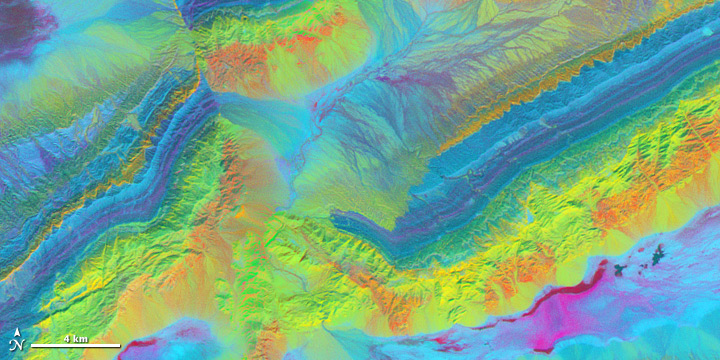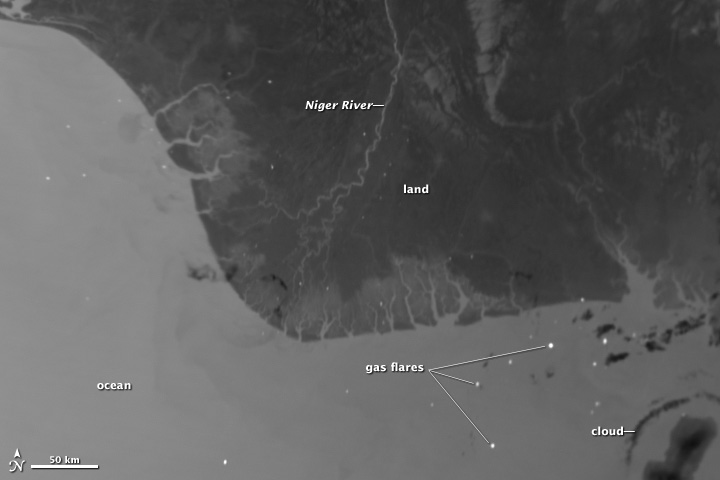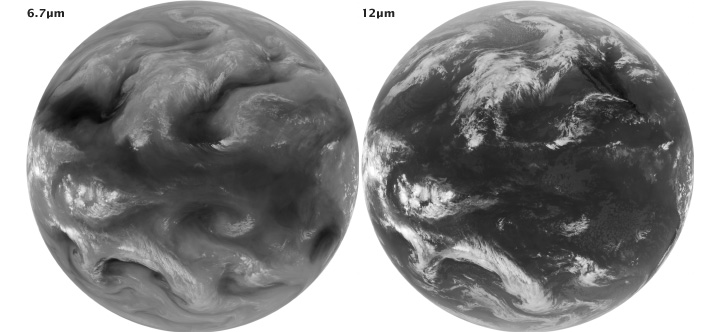

Near infrared (NIR) light includes wavelengths between 700 and 1,100 nanometers. Water absorbs NIR, so these wavelengths are useful for discerning land-water boundaries that are not obvious in visible light. The below image shows the near infrared view of the Piqiang Fault, China. Stream beds and the wetland in the upper left corner are darker than the surrounding arid landscape because of their water content. (See a natural color view of the scene here.) Plants, on the other hand, reflect near infrared light strongly, and healthy plants reflect more than stressed plants. Finally, near infrared light can penetrate haze, so including this band can help discern the details in a smoky or hazy scene.

Shortwave infrared (SWIR) light includes wavelengths between 1,100 and 3,000 nanometers. Water absorbs shortwave infrared light in three regions: 1,400, 1,900, and 2,400 nanometers. The more water there is, even in soil, the darker the image will appear at these wavelengths. This means SWIR measurements can help scientists estimate how much water is present in plants and soil. Shortwave-infrared bands are also useful for distinguishing between cloud types (water clouds versus ice clouds) and between clouds, snow, and ice, all of which appear white in visible light. Newly burned land reflects strongly in SWIR bands, making them valuable for mapping fire damage. Active fires, lava flows, and other extremely hot features “glow” in the shortwave-infrared part of the spectrum. In the image below, different types of sandstone and limestone make up the mountains around China’s Piqiang Fault. Each rock type reflects shortwave infrared light differently, making it possible to map out geology by comparing reflected SWIR light. Enhancing the subtle differences between the 3 bands of reflected shortwave infrared light used to make this image gives each mineral a distinctive, bright color.

Midwave Infrared (MIR) ranges from 3,000 to 5,000 nanometers and is most often used to study emitted thermal radiation in the dark of night. Midwave infrared energy is also useful in measuring sea surface temperature, clouds, and fires. The images below contrast a visible-light nighttime view of the Niger River Delta with the same view in midwave infrared; both images are from the Visible Infrared Imaging Radiometer Suite (VIIRS) on the Suomi-NPP satellite. The day-night band shows visible light—the lights of Port Harcourt and Benin City, bright gas flares, and moonlight reflected off clouds. The midwave infrared image shows emitted thermal radiation. The warmer ocean and river are pale, while the cold land and clouds are dark, and the hot gas flares are bright.


Visible light at night (top) shows cities, gas flares, and moonlight reflected off clouds. Flares also shine in midwave infrared (lower); this view also contrasts warm waters with colder land and clouds. (NASA/NOAA image by Jesse Allen and Robert Simmon, using VIIRS data from NGDC.)
Infrared (IR) light—specifically between 6,000 to 7,000 nanometers—is critical for observing water vapor in the atmosphere. Though water vapor makes up just 1 to 4 percent of the atmosphere, it is an important greenhouse gas. It is also the basis for clouds and rainfall. Water vapor absorbs and re-emits energy in this range, so infrared satellite observations can be used to track water vapor. Such observations are integral to weather observations and forecasts.

Mid-infrared (7µm) and thermal-infrared (12 µm) images showing water vapor (left), and temperature (right). The images are inverted to better show clouds: cold areas are light and warm areas are dark. (NASA/NOAA images by Robert Simmon, using data from the GOES Project Science Team.)
Thermal or longwave infrared (TIR or LWIR) light includes wavelengths between 8,000 and 15,000 nanometers. Most of the energy in this part of the spectrum is emitted (not reflected) by the Earth as heat, so it can be observed both day and night. Thermal infrared radiation can be used to gauge water and land surface temperatures; this makes it particularly useful for geothermal mapping and detection of heat sources like active fires, gas flares, and power plants. Scientists also use TIR to monitor crops. Actively growing plants cool the air above them by releasing water through evapotranspiration, so TIR light helps scientists assess how much water the plants are using.